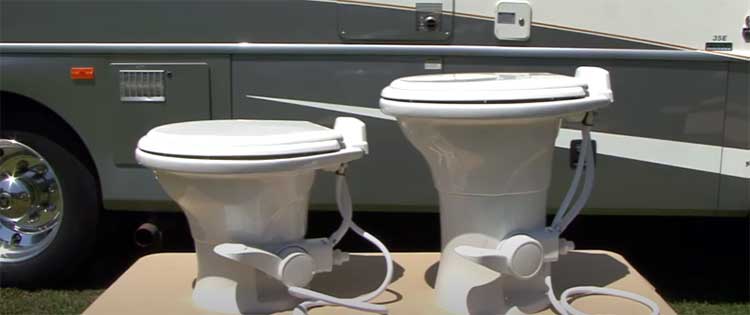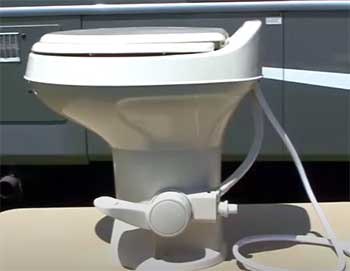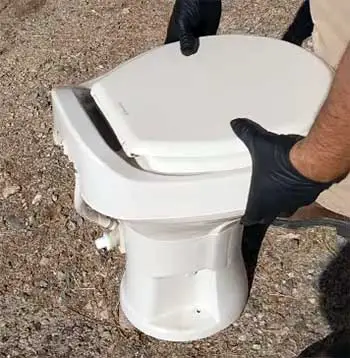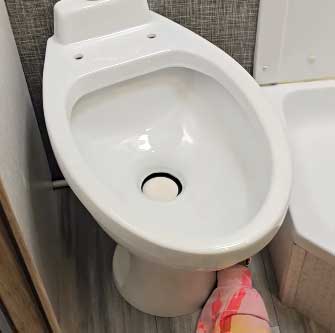As an RVer, I know the toilet is more than a minor detail; it’s central to your comfort. I’ve spent enough time with the Dometic 300, 310, and 320 to understand the subtle but crucial differences.
Making the wrong choice can be a daily frustration, while the right one elevates your life on the road. My goal is to give you a clear, user-focused breakdown of these popular models, sharing my firsthand analysis so you can confidently choose the best throne for your travels.
A Quick Glance
| Feature | Dometic 300 | Dometic 310 | Dometic 320 |
| Bowl Material | All Plastic | Ceramic Bowl, Plastic Base | All Ceramic |
| Bowl Shape | Standard Round | Standard Round | Elongated |
| Seat & Lid | Standard Plastic | Slow-Close Wood | Slow-Close Wood |
| Flush Mechanism | Foot Pedal, Triple-Jet | Foot Pedal, PowerFlush | Foot Pedal, PowerFlush with Rim Wash |
| Height | Standard (approx. 18″) or Low Profile | Standard (approx. 18″) or Low Profile | Standard (approx. 18″) or Low Profile |
| Water Consumption | Approx. 1 pint per flush | Approx. 1 pint per flush | Approx. 1 pint per flush |
| Installation | 2-bolt | 2-bolt | 2-bolt |
| Aesthetics | Basic, functional | More residential look | Premium, residential look |
| Weight | Lightweight | Mid-weight | Heaviest |
The Dometic 300: The Entry-Level Option

When I first encountered the Dometic 300, it was in a budget-friendly travel trailer.
It’s the kind of toilet that gets the job done without any fuss or fanfare.
It’s an all-plastic unit, which makes it incredibly lightweight.
If you’re conscious about every pound you’re adding to your rig, this is a significant advantage.
The installation is a breeze, a simple two-bolt setup that most DIY-inclined RVers can handle in under an hour.
The foot pedal flush is a standard feature in the Dometic line, and the 300 is no exception. A light press adds water to the bowl, and a full press initiates the flush.
The triple-jet flush is surprisingly effective for a plastic bowl, providing a decent amount of coverage to clear waste. It’s also water-efficient, using about a pint per flush, which is a big plus when you’re boondocking and water is a precious commodity.
However, the all-plastic construction is also its biggest downfall. It just doesn’t have the same residential feel as its more expensive siblings. The plastic bowl is more prone to staining and can hold onto odors if not cleaned meticulously.
I’ve also found that the plastic-on-plastic sound of the seat and lid can be a bit jarring in the quiet of the night.
Pros of The Dometic 300
- Lightweight: The all-plastic construction makes it ideal for RVs where weight is a primary concern.
- Affordable: It’s the most budget-friendly option in the 300 series, making it a great choice for those on a tight budget.
- Easy Installation: The two-bolt installation is straightforward and can be done by most RV owners with basic tools.
- Water-Efficient: Its low water consumption is a significant advantage for dry camping.
Cons of The Dometic 300
- All-Plastic Construction: This can feel less durable and less “homey” than a ceramic toilet.
- Prone to Stains and Odors: The plastic bowl requires more frequent and thorough cleaning to prevent staining and odor retention.
- Basic Aesthetics: It has a very functional, no-frills look that might not appeal to everyone.
- Recall History: The Dometic 300 has a known recall issue, which is a significant concern for potential buyers.
The Dometic 310: A Step Up in Comfort and Quality

My first experience with the Dometic 310 was in a mid-range fifth wheel, and the difference from the 300 was immediately noticeable. The 310 is what I’d call the sweet spot in the Dometic 300 series.
It strikes a fantastic balance between affordability, features, and a more residential feel.
The most significant upgrade in the 310 is the ceramic bowl. This single feature elevates the entire experience. The ceramic is easier to clean, more resistant to stains and odors, and just feels more substantial.
The base is still plastic to keep the weight down, but the part that matters most, the bowl, is a solid, high-quality ceramic.
The 310 also introduces a slow-close wooden seat and lid. This might seem like a small detail, but trust me, it’s a game-changer. No more accidental slamming of the toilet seat in the middle of the night! The wooden seat also adds to the overall residential feel and comfort.
The flush mechanism gets an upgrade as well, with the introduction of the PowerFlush system. While still a foot pedal operation, the PowerFlush provides a more vigorous and swirling flush that does a better job of cleaning the entire bowl. It still maintains the same water efficiency as the 300, which is impressive.
Pros of The Dometic 310
- Ceramic Bowl: A major upgrade in terms of cleanliness, odor resistance, and a more residential feel.
- Slow-Close Wooden Seat: A touch of luxury that eliminates slamming and enhances comfort.
- PowerFlush System: A more powerful and effective flush that keeps the bowl cleaner.
- Good Value for Money: It offers a significant upgrade from the 300 without the premium price tag of the 320.
Cons of The Dometic 310
- Heavier than the 300: The ceramic bowl adds some weight, which might be a consideration for some RV owners.
- Plastic Base: While the bowl is ceramic, the base is still plastic, which might be a turn-off for those seeking an all-ceramic unit.
The Dometic 320: The Pinnacle of RV Toilet Luxury
I had the pleasure of using a Dometic 320 in a high-end Class A motorhome, and it’s as close as you can get to a residential toilet in an RV. The 320 is the top-of-the-line model in the 300 series, and it shows in every detail.

The most striking feature of the 320 is its elongated, all-ceramic bowl.
This is a true game-changer for comfort, especially for taller individuals.
The elongated shape provides more support and just feels more natural to use.
The all-ceramic construction gives it a premium, solid feel, and it’s incredibly easy to clean.
The flush mechanism is the same powerful PowerFlush system found in the 310, but with the addition of a rim wash feature. This ensures that water is distributed evenly around the entire rim of the bowl, providing a thorough and hygienic flush every time.
The 320 also comes standard with a high-quality, slow-close wooden seat that complements the elongated bowl perfectly. The overall aesthetic is sleek and modern, and it can truly elevate the look of your RV bathroom.
However, all this luxury comes at a price. The 320 is the most expensive model in the series, and it’s also the heaviest. The elongated bowl also requires more floor space, so it’s crucial to measure your bathroom layout carefully before considering this upgrade.
Pros of the Dometic 320
- Elongated, All-Ceramic Bowl: The ultimate in comfort and hygiene, with a true residential feel.
- Premium Aesthetics: Its sleek and modern design can significantly enhance the look of your RV bathroom.
- Rim Wash Feature: Provides a superior, more hygienic flush that cleans the entire bowl.
- Unmatched Comfort: The elongated bowl and high-quality wooden seat offer a level of comfort that is unparalleled in the RV world.
Cons of the Dometic 320
- Most Expensive: It comes with a premium price tag that might not fit everyone’s budget.
- Heaviest Option: The all-ceramic construction makes it the heaviest model, which could be a concern for some RVs.
- Requires More Space: The elongated bowl requires more floor space, so it’s not suitable for all RV bathroom layouts.
Also Read: Is BioLet Composting Toilet Worth It?
Key Differences Among Dometic 300, 310 And 320
When you line up the Dometic 300, 310, and 320, they might seem similar at first glance. They all share a brand name and a basic function.
But as someone who has gotten up close and personal with each of them, I can tell you the differences are not just noticeable; they are significant enough to completely change your daily experience on the road.
The evolution from the 300 to the 320 isn’t just about adding features; it’s about a fundamental shift in philosophy, moving from pure utility to residential-style comfort. Let’s break down exactly where these models diverge.
- Bowl Material and Construction: The Core of the Matter

This is, in my opinion, the most critical differentiator. It impacts everything from cleaning and maintenance to the toilet’s longevity and overall feel.
The Dometic 300 is an all-plastic affair. The bowl, the base, the lid—everything is plastic.
The primary advantage here is weight. It’s feather-light, which is a real consideration if you’re towing a small trailer or are meticulous about your gross vehicle weight rating (GVWR).
However, the downside of a plastic bowl is significant. Over time, plastic is more susceptible to scratching from abrasive cleaners or even just regular use.
These tiny scratches can trap waste particles and bacteria, leading to stubborn stains and lingering odors that even the most diligent cleaning can’t fully eradicate. There’s also a certain “flex” to it that just doesn’t inspire confidence. It feels like a functional piece of camping equipment, not a permanent fixture in a home.
Then comes the Dometic 310, which I see as the great compromise. Dometic smartly upgraded the most important part: the bowl is made of solid, vitreous ceramic. The base, however, remains plastic. This hybrid design is brilliant.
You get the superior hygiene, stain resistance, and solid feel of a ceramic bowl where it counts the most. It’s so much easier to clean; a quick wipe and it looks brand new. It doesn’t hold onto odors the way its plastic counterpart does.
By keeping the base plastic, Dometic keeps the weight manageable, making it a viable upgrade for most RVs without a huge weight penalty.
The Dometic 320 takes it all the way. It boasts a full, one-piece ceramic bowl and base. This makes it the heavyweight champion of the lineup, but also the most robust and premium-feeling. There’s zero flex.
It feels exactly like a high-quality residential toilet. The solid ceramic construction is the easiest to clean and the most durable in the long run. It has a presence in the bathroom that the other two lack, feeling less like an RV toilet and more like a true porcelain throne.
The trade-off is its considerable weight, which might be a deal-breaker for smaller rigs or those already close to their weight limits.
- Bowl Shape and Comfort: It’s Not Just About Looks
The shape of the bowl directly translates to user comfort. This is a distinction you’ll feel immediately.
The Dometic 300 and 310 both feature a standard round bowl. This is a space-saving design, compact and efficient, making it suitable for the tight confines of many RV bathrooms. It’s perfectly functional and gets the job done.
For many people, especially on shorter trips, it’s entirely adequate. However, for longer-term travel or for larger individuals, a round bowl can feel a bit cramped.
This is where the Dometic 320 shines. It introduces an elongated bowl, just like you’d find in most modern homes. That extra few inches of length in the front makes a world of difference. It provides more support and creates a much more comfortable and natural sitting position.
If you’re a full-timer or someone who spends extended periods in your RV, this upgrade to an elongated bowl is a luxury that you will appreciate every single day. The caveat, of course, is space. An elongated bowl juts out further into the bathroom.
You absolutely must measure your space before even considering the 320. I’ve heard stories of people excitedly buying a 320 only to find their bathroom door won’t close once it’s installed.
- Seat and Lid: The Unsung Hero of Comfort
You might not think a toilet seat makes a big difference, but you’d be wrong. It’s a touchpoint you interact with daily.
The Dometic 300 comes with a basic, thin plastic seat and lid. It’s functional, but that’s about it. It feels flimsy, and the sound of it dropping can echo through a quiet RV. It’s a cost-saving measure, and it feels like one.
The Dometic 310 and 320 both provide a significant upgrade to a solid wood, slow-close seat. The moment you use it, you feel the difference. The wood is sturdier and feels warmer and more comfortable than the cold plastic.
And the slow-close feature is pure genius. No more accidental slams waking up your partner or kids. You can just tap the lid, and it glides down silently. It’s one of those small, quality-of-life improvements that adds a touch of residential luxury to your rig.
- Flush Technology: Power and Performance
While all three models use a foot pedal, the way they flush is not the same.
The Dometic 300 utilizes what it calls a triple-jet flush. Three streams of water shoot out to clear the bowl. For a plastic bowl, it does a reasonably good job, but I’ve found that it can sometimes miss spots, requiring a second flush or some help from a toilet brush.
The Dometic 310 and 320 feature the enhanced PowerFlush system. This technology creates a powerful, swirling vortex of water that covers the entire bowl more effectively. The flush is noticeably more vigorous and does a much better job of clearing waste in a single go.
This not only saves water but also keeps the ceramic bowl cleaner for longer. The Dometic 320 takes this one step further by incorporating a full rim wash. Water flows from outlets all around the top rim, ensuring no part of the bowl is missed during the flush.
This is the most hygienic and effective flush of the three, mimicking the performance of high-end home toilets.
Who I Think Each Toilet Is For?

Having used all three, my personal preference leans towards the Dometic 310.
For me, it offers the perfect blend of upgraded features and affordability.
The ceramic bowl and slow-close seat are significant improvements over the 300, without the added weight and cost of the 320.
It’s a reliable and comfortable toilet that has served me well on numerous trips.
However, the best toilet for you will ultimately depend on your individual needs and priorities.
If you’re a weekend warrior with a smaller trailer or someone who is extremely conscious of every ounce of weight, the Dometic 300 is a perfectly serviceable option. It’s lightweight, affordable, and gets the job done. Just be mindful of the potential recall and the extra cleaning it might require.
For the majority of RVers, from full-timers to frequent vacationers, I believe the Dometic 310 is the ideal choice.
You get the all-important ceramic bowl and the creature comfort of a slow-close seat, making your home on wheels feel just a little more like home. It’s a worthwhile investment that you’ll appreciate every single day.
If you have a luxury rig, ample space, and a budget to match, and you refuse to compromise on comfort, then the Dometic 320 is the toilet for you. The elongated bowl is a true luxury, and the overall quality is second to none. You’ll have the most comfortable and residential-feeling toilet available for an RV.
No matter which you choose, you’re getting a product from a reputable brand in the RV industry.
By considering your travel style, budget, and the specifications of your RV, you can confidently select the Dometic toilet that will be the perfect porcelain partner for all your adventures to come. So, take it from me, do your homework, and you’ll be sitting pretty on your next road trip.
Also Read: Is DeerValley Toilet Worth It?
Frequently Asked Questions (FAQ)
A popular alternative to the Dometic 320 is the Thetford Aqua-Magic V. It also features a residential-style design and is known for its reliability and ease of use.
The standard height Dometic 310 toilet is approximately 18 inches tall from the floor to the top of the seat, providing a comfortable, residential-like height.
No, Thetford and Dometic are two separate and competing companies. Both are leading manufacturers of RV sanitation products.
To check if your Dometic 300 toilet is part of a recall, you will need to locate the model and serial number on a sticker on the toilet’s base. You can then contact Dometic’s customer service or check their official website for recall information.
Wrapping Up
After breaking down all the features, I stand by my experience. The best toilet isn’t a one-size-fits-all answer; it’s about what you value most.
Whether you prioritize the lightweight utility of the 300, the balanced comfort of the 310, or the residential luxury of the 320, the decision rests on your specific needs, your rig’s limitations, and your budget.
I’ve laid out the facts from a real-world perspective. Now, you have the insight to choose the model that will make your adventures that much better.
